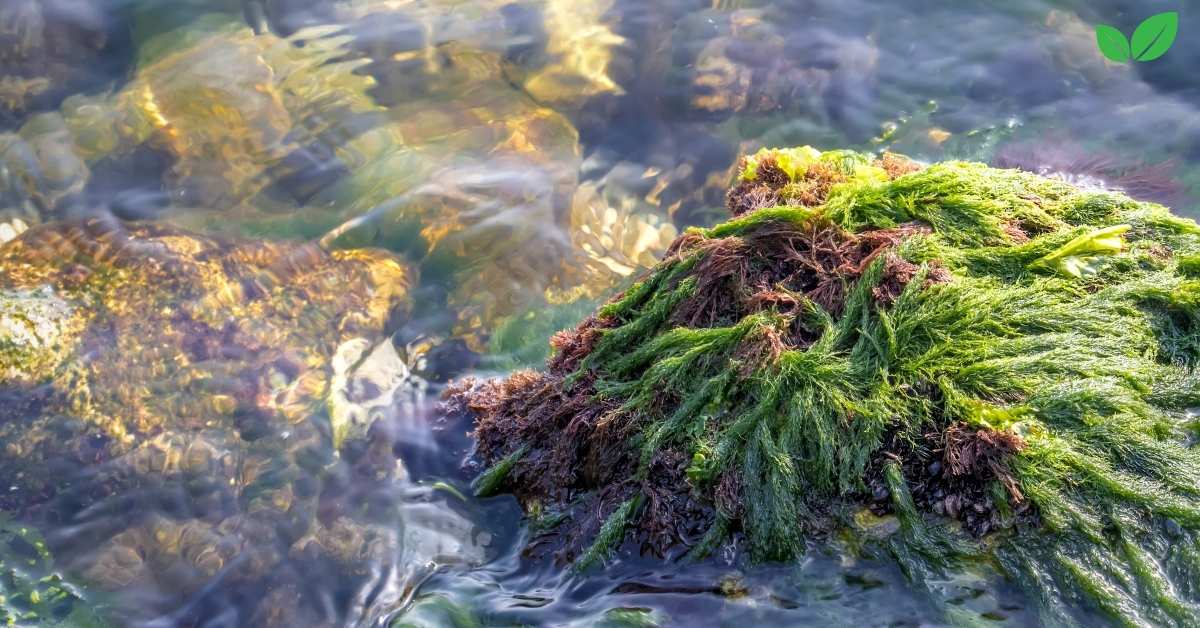Sea moss, also known as Irish moss or by its scientific name Chondrus crispus, is a species of red algae that thrives in the cool waters of the Atlantic Ocean along the rocky coasts of North America, Europe, and the Caribbean. It has gained widespread popularity in recent years due to its nutritional and medicinal properties. However, sea moss plays a more significant role beyond its use in health and wellness; it is also a critical element of marine ecosystems and a key contributor to environmental balance.
In this article, we will explore the environmental niche of sea moss, including its biological role in marine ecosystems, its environmental benefits, and the importance of sustainable harvesting practices. Additionally, we’ll look into how it is utilized by humans, its impact on global trade, and the conservation efforts aimed at protecting this valuable marine resource.
The Biology of Sea Moss
It belongs to the class Rhodophyta, a group of red algae known for their resilience and adaptability to diverse ocean environments. This species is found clinging to rocks in tidal pools and shallow waters, where it is constantly exposed to changing environmental conditions, including shifts in temperature, salinity, and wave action. Its unique physiological features allow it to thrive in these challenging habitats, making it a fascinating subject of study for marine biologists and ecologists.

Physical Characteristics of Sea Moss
Sea moss has a cartilaginous texture, with a frond-like appearance. Its color ranges from yellow-green to dark purple, depending on the specific environment in which it grows. The alga’s surface is smooth, and it can grow up to 20 centimeters in length, with several branching arms. It’s ability to change its pigmentation and morphology depending on environmental conditions is an adaptive trait that aids its survival in different marine settings.
Ecological Role of Sea Moss
Sea moss plays a crucial role in coastal ecosystems, particularly in nutrient cycling and providing habitat for marine organisms. It is an autotrophic organism, meaning it produces its own food through photosynthesis. Sea moss absorbs sunlight and carbon dioxide to produce oxygen and organic compounds, contributing to primary production in marine ecosystems. This process is essential for supporting the food chain, as many marine species depend on the organic matter produced by it and other algae.
Moreover, sea moss acts as a shelter for small marine creatures such as mollusks, crustaceans, and juvenile fish. These organisms hide within the sea moss fronds to avoid predators and find food, contributing to biodiversity in coastal habitats. By providing habitat and food for various marine life forms, sea moss plays an integral part in maintaining healthy and balanced ecosystems.
Environmental Benefits of Sea Moss
In addition to its ecological role, it offers a range of environmental benefits. It acts as a natural biofilter, improving water quality in the areas where it grows. Sea moss can absorb excess nutrients, such as nitrogen and phosphorus, from the water, which helps prevent harmful algal blooms. These blooms can cause significant damage to marine life by depleting oxygen levels in the water, leading to dead zones where little to no aquatic life can survive.
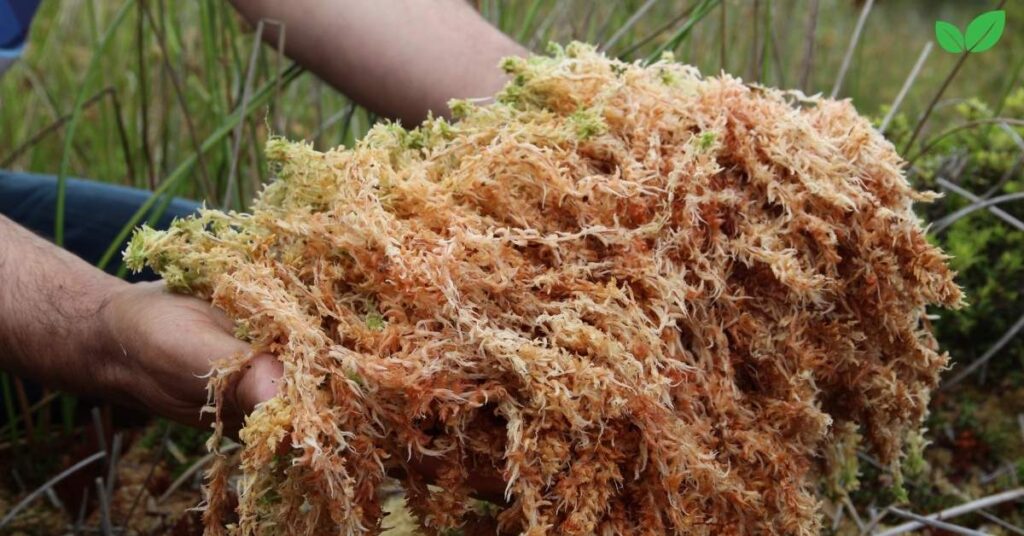
Carbon Sequestration
Like other forms of algae, it contributes to carbon sequestration, which is the process of capturing and storing atmospheric carbon dioxide (CO2). As it grows, sea moss absorbs CO2 from the water and atmosphere, converting it into organic carbon during photosynthesis. This not only helps reduce the concentration of CO2, a greenhouse gas but also mitigates the effects of ocean acidification. Ocean acidification occurs when excess CO2 dissolves in seawater, lowering the pH and threatening the health of marine organisms such as coral reefs, shellfish, and fish.
Erosion Control
The dense growth of this weed along coastlines helps stabilize the ocean floor and prevent coastal erosion. By anchoring itself to rocks and other hard surfaces, it reduces the impact of strong currents and waves, which can otherwise cause the shoreline to erode. This natural protection is particularly important for vulnerable coastal communities that rely on healthy marine ecosystems to support fisheries, tourism, and coastal infrastructure.
Human Use of Sea Moss
For centuries, it has been harvested and used by coastal communities for its nutritional, medicinal, and industrial properties. The algae are rich in essential vitamins and minerals, including iodine, calcium, potassium, and vitamins A, C, and K. These nutrients make it a valuable resource for promoting human health, and its popularity has surged in recent years due to its use in dietary supplements, skincare products, and as a thickening agent in food production.
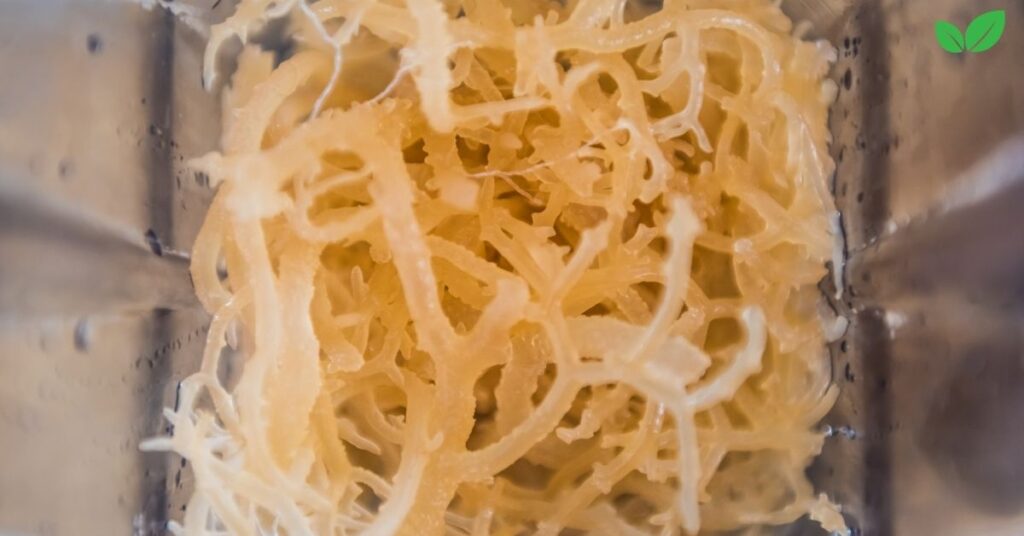
Nutritional Benefits
It is commonly used as a superfood, praised for its ability to boost immune function, improve digestion, and support skin health. Its high iodine content is particularly beneficial for thyroid function, while its gelatinous nature makes it an excellent natural source of fiber, aiding in gut health. In some cultures, sea moss is traditionally consumed as a drink, often mixed with spices and milk, providing a nutritious and energizing beverage.
Industrial Applications
Beyond its use as a superfood, it has industrial applications due to its high carrageenan content. Carrageenan is a natural polysaccharide extracted from red algae that is widely used as a thickener, emulsifier, and stabilizer in food products such as ice cream, yogurt, and plant-based milk. Additionally, carrageenan has applications in cosmetics and pharmaceuticals, where it is used in lotions, gels, and medications to provide consistency and stability.
Economic Impact of Sea Moss Harvesting
The demand for sea moss has created a lucrative market for coastal communities involved in its harvesting and trade. In countries like Jamaica, Ireland, and parts of Southeast Asia, farming has become a significant source of income. This growing market has the potential to support sustainable livelihoods and economic development, particularly in rural and coastal areas where alternative employment opportunities may be limited.
However, with the rise in demand comes the risk of overharvesting and environmental degradation. Unsustainable harvesting practices can damage marine ecosystems, disrupt the balance of species, and lead to the depletion of its populations. It is therefore essential to implement responsible harvesting methods and encourage the development of sustainable sea moss farming practices.
Sustainable Harvesting and Conservation Efforts
Given the ecological importance of sea moss and the increasing demand for its products, sustainable harvesting practices are crucial for preserving both the marine environment and the livelihoods of those who depend on its production. Conservation efforts are needed to protect natural sea moss populations, prevent habitat destruction, and ensure that sea moss farming is carried out in an environmentally responsible manner.
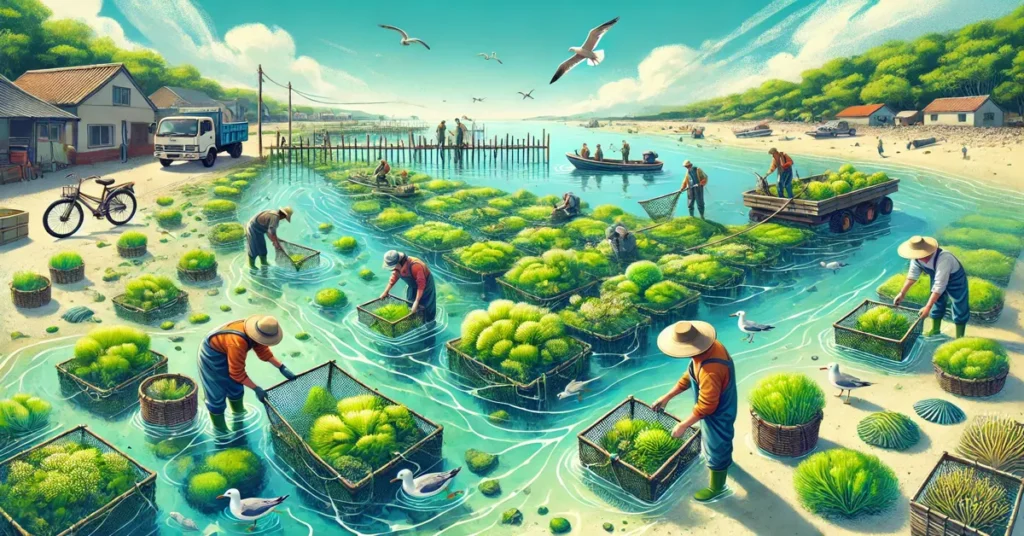
Sustainable Sea Moss Farming
Sustainable sea moss farming involves cultivating the algae in a controlled environment that mimics its natural habitat without causing harm to marine ecosystems. This practice can help meet the growing demand for it while reducing the pressure on wild populations. Its farms can be established in coastal waters where the algae are grown on ropes or nets suspended in the water. This method allows the sea moss to grow naturally while minimizing environmental impact.
Sustainable sea moss farming has the added benefit of improving local water quality. Like wild sea moss, farmed it can act as a biofilter, absorbing excess nutrients from the water and reducing the risk of harmful algal blooms. Additionally, sea moss farming requires minimal inputs, such as fertilizers or pesticides, making it an environmentally friendly option for coastal aquaculture.
Harvesting Guidelines
For those who continue to harvest wild sea moss, there are several best practices that can help protect the environment. One key guideline is to avoid harvesting it during its reproductive season, allowing the algae to regenerate and maintain healthy populations. Harvesters should also ensure that they only take a portion of the sea moss from each site, leaving enough behind to support regrowth and provide habitat for marine life.
By adhering to these sustainable harvesting guidelines, coastal communities can continue to benefit from its production while safeguarding the health of marine ecosystems.
Marine Protected Areas
Marine protected areas (MPAs) can play a crucial role in conserving its habitats and other marine ecosystems. MPAs are designated zones where human activity is regulated to minimize environmental impact and protect biodiversity. In areas where sea moss is abundant, MPAs can help ensure that the algae are not overharvested and that their role in the ecosystem is preserved.
These protected areas also support scientific research, allowing marine biologists and conservationists to study it and its interactions with other species. By gaining a deeper understanding of how sea moss contributes to ecosystem health, researchers can develop more effective conservation strategies and promote the sustainable management of marine resources.
Sea Moss and Climate Change
The role of sea moss in combating climate change cannot be overstated. As a carbon sink, it helps mitigate the effects of global warming by absorbing CO2 from the atmosphere. This process contributes to the reduction of greenhouse gases and supports the resilience of marine ecosystems in the face of climate change.
However, it is also vulnerable to the impacts of climate change. Rising ocean temperatures, acidification, and changes in ocean currents can all affect sea moss growth and distribution. In some regions, these environmental changes may lead to a decline in sea moss populations, threatening both marine biodiversity and the communities that rely on sea moss for their livelihoods.
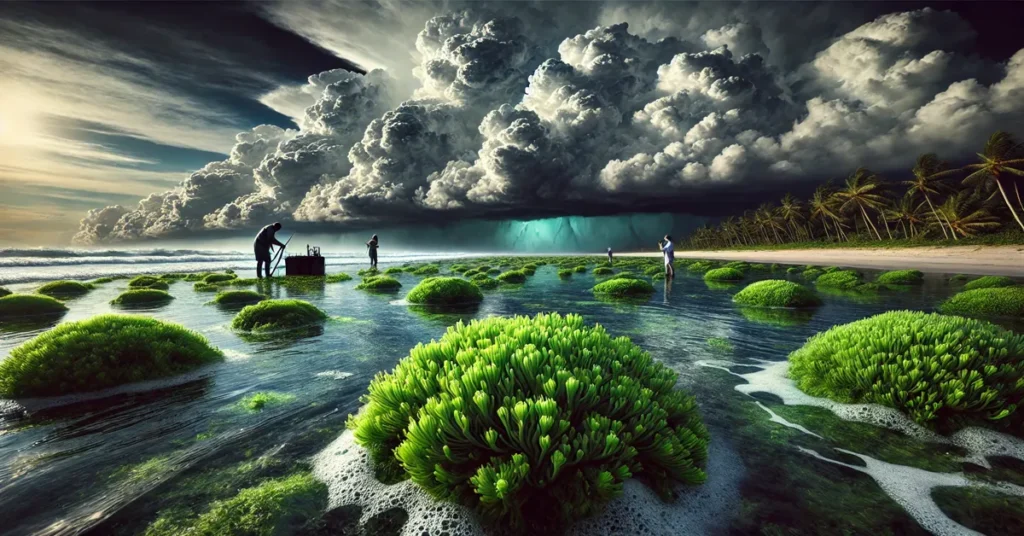
The Importance of Climate Adaptation Strategies
To protect sea moss and other marine species, it is essential to implement climate adaptation strategies that address the root causes of environmental degradation. These strategies include reducing greenhouse gas emissions, protecting coastal habitats, and restoring damaged ecosystems. By investing in marine conservation and promoting sustainable practices, we can help ensure that it continues to thrive in a changing climate.
Conclusion
Sea moss is not just a popular superfood; it is a vital component of marine ecosystems and a key player in the global fight against climate change. Its role in nutrient cycling, carbon sequestration, and habitat provision underscores the importance of protecting this valuable resource. As the demand for sea moss continues to grow, it is critical that we adopt sustainable harvesting practices and invest in conservation efforts that preserve marine biodiversity and support coastal communities.
By understanding the environmental niche of sea moss and promoting responsible use, we can ensure that this remarkable alga continues to contribute to the health and balance of our oceans for generations to come. Sustainable management of sea moss is not only a matter of protecting a single species but also an essential part of safeguarding the broader marine environment upon which so many species, including humans, depend.
Read More: The Ocean Dragon: Exploring the Leafy Sea Dragon and Its Environmental Importance

